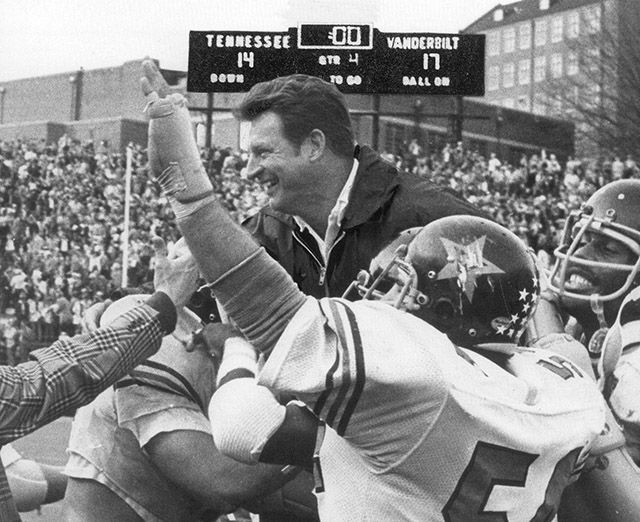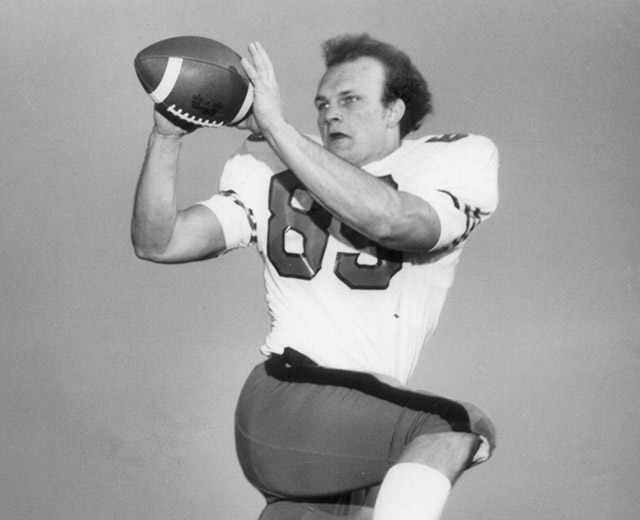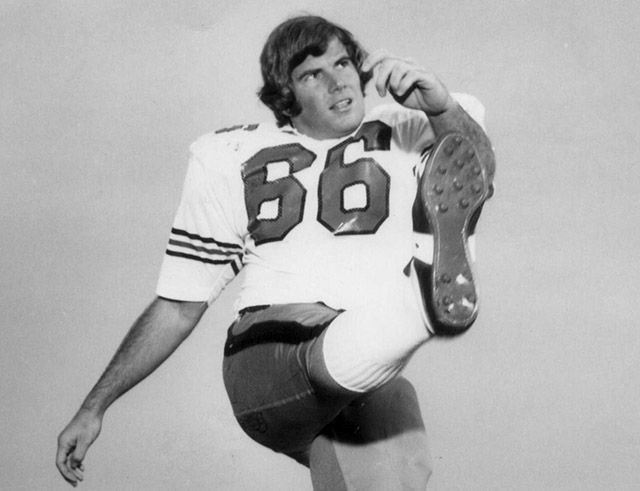Nov. 23, 2015

Coach Fred Pancoast is lifted on his players’ shoulders after victory over Tennessee in 1975.
Commodore History Corner Archive
This week Vanderbilt will face the Tennessee Vols on the gridiron for their 110th meeting in Neyland Stadium. The series began in 1892 with a 22-4 Commodores’ victory in Nashville. A few weeks later, Vanderbilt defeated the Vols in Knoxville, 10-0.
The last two times that Vanderbilt has defeated Tennessee in Knoxville was in 2013, a 14-10 defensive battle, and in 2005 when quarterback Jay Cutler led the Commodores to a 28-24 victory. The 2005 Vanderbilt win was the first in 30 years for Vanderbilt in Knoxville.
At that time, first-year Commodores’ head coach Fred Pancoast (1975-78) led Vanderbilt while Bill Battle coached the Vols. The Commodores came close to winning the year before with the Vols scoring a last minute touchdown and two-point conversion for a disappointing 21-21 tie at Dudley Field.
On this November afternoon in Neyland Stadium in 1975, the Commodores and Vols entered the game with identical 6-4 records. Over 71, 943 fans watched Fred Fisher of Vanderbilt and Vols quarterback Randy Wallace lead their respective teams. But, it would be an average kick by the Commodore punter to attract the attention by the game’s end.
The Commodores struck first on an 80-yard scoring drive. The key play was a 50-yard Fisher to Mike Gothard pass. Lonnie Sadler forced his way into the end zone from the one-yard line to give Vanderbilt a 7-0 lead. Mark Adams added the conversion.
Defense took over for both teams for the rest of the first half. With less than a minute, Fisher attempted a second down pass, but was sacked. The ball popped loose into a pile of players. Vols Defensive end, Ron McCartney, came up with the ball and raced 25 yards before being dragged down at the Commodores’ 13-yard line.
Tennessee managed to get the ball into the end zone three plays later on a one-yard pass from Wallace to Tommy West. Jimmy Gaylor knotted the game at 7-7 with his conversion.
In the third quarter, the Vols would take their only lead of the game. Tennessee was on its 37-yard line when two key screen passes to Larry Seivers kept the drive alive. Stanley Morgan blasted his way from the four-yard line to give the Vols a 14-7 advantage.
Vanderbilt began a fourth quarter march from its 20-yard line. The Commodores’ line was effective during the attack with Sadler, Fisher, Adolph Groves, David Johnson and Roger Alsup. Fisher carried the ball across midfield on a fake tight end reverse for nine yards. Passes to Alsup and Sadler followed by an elusive run by Johnson moved the ball to the UT nine-yard line. Sadler then scampered around the left side on a pitch for the tying TD. Vanderbilt 14, Tennessee 14.
Vandy’s defensive back, Ed Oaks, made the deciding play of the game. Before the Vols could continue a drive, Oaks grabbed a pass intended for West and raced 26 yards to the Vols six-yard line. The Vols defense stiffened and Vanderbilt was stopped. Place-kicker Adams came on to drill an 18-yard field goal to put Vanderbilt ahead 17-14. There were still nine minutes left on the clock.
Gary Roach came in at quarterback for Tennessee. With the ball on the Vols 37-yard line and a third-and-18, Roach tossed a pass to Jeff Moore. A Commodore defender, on a pass, appeared to have bumped UT wide receiver Jeff Moore. The official on the scene appeared to reach for his penalty flag, but quickly signaled an incomplete pass. The Vols bench and fans were hysterical.
Craig Colquitt boomed a 57-yard punt out of bounds to the Vanderbilt six-yard line. The Commodores were deep in their own territory while the Vols fans continued to display their disapproval over the non-call on the Moore contact. Next to face a pressure situation was Vanderbilt’s punter/tight end Barry Burton.

Barry Burton
Burton was called upon to punt when the Commodores failed to advance the ball. As Burton stepped into his usual punting position, Vols fans saw optimism and cheered for the familiar Commodore player. Vandy fans were concerned.
In 1973, Burton was in a similar situation when the Commodores were winning 17-13. Burton was about to punt from deep inside his territory when he attempted to run for a Commodore first down. He came up short and the Vols went on to score the winning touchdown for a 20-17 victory in Neyland Stadium.
In 1974 in Nashville, Burton was standing near his goal line with Vanderbilt leading the Vols, 21-13. Burton dropped the snap that went directly into his hands. The Vols recovered the ball, scored a TD and two-point conversion in the last seconds to tie the game at 21-21.
Adding to the drama the Tennessee PA announcer told the stadium crowd, “Back to punt from the end zone – and it is Barry Burton!” The partisan crowd stood and roared.
For the third year in a row Burton was asked to get the ball off in a pressure situation. This time Burton was standing in his own end zone with a slim three-point lead and four minutes left in the game. Burton got off a 41-yard kick that Morgan returned 21 yards. Tennessee had a first down on the Vanderbilt 30-yard line with a deafening crowd behind them and momentum.

Mark Adams
However, the Commodores’ defense was alive and well. Adams, who also played linebacker, charged into the Vols line on first down to stop Mike Gayles for no gain. Jay Chesley, a Commodore two-time First Team All-SEC defensive back, then streaked into the UT backfield to slam Morgan for a three-yard loss. Wallace, who was back in the game, overthrew Seivers on a pass attempt.
On fourth down, Gaylor lined up to attempt a game-tying field goal from 50 yards. Earlier in the game Vandy defensive end Dennis Harrison blocked a long field goal attempt by Gaylor. The field goal attempt was a fake and a pass to Tim Fitchpatrick fell incomplete  securing a Commodore 17-14 victory. Vanderbilt had defeated the Vols for the first time since a 7-0 victory in Nashville in 1964.
The player to attract most of the attention after the game was Burton who would be a two-time First Team All-SEC tight end and named a tight end All-American. His pressurized 41-yard punt wasn’t anything spectacular, but getting it off was a key moment in the contest.
Burton’s failed punting attempts in the previous two UT games did haunt him.
“I would have kicked it farther except I tried to burst the football,” Burton said after the game. “I tried to kick it 90 yards. It was the greatest feeling of my life to look over at Battle in those last moments when the victory was ours. I couldn’t help yelling at him, ‘The pressure’s on you now.'”
The emotional senior Burton was given the game ball by Pancoast and continued, “I knew I wouldn’t leave school without beating these guys. I had a very personal debt to pay. If we hadn’t won this year, I’d slip back on the squad next year.”
It was estimated that 14,000 Vanderbilt fans attended the game, filling two sections. The Commodores hoped that a 7-4 record would gain them a bowl bid, but most of the invitations were gone. The Vols did beat Hawaii, 28-6 the following week in Honolulu. Tennessee finished the season 7-5, also without a bowl bid.
Traughber’s Tidbit: Vanderbilt constructed its football indoor practice facility in 2013, but dreams of an indoor facility for football came as early as the late 1940’s. An original concept was to use the planned new gymnasium (Memorial Gym) as an indoor practice facility for football. From Roy Neel’s 1975 book, Dynamite! 75 Years of Vanderbilt Basketball: “What we found was that the field house conceptâ€â€a dirt floor with a portable basketball playing floorâ€â€was a failure. The Purdue officials admitted this, as did the people at Michigan. When you cover over the ground, the worms die from lack of moisture, sun, etc., and thus fail to aerate the dirt, making it as hard as concrete. This makes it impractical to practice football, which is what Vanderbilt originally thought they wanted possible in an indoor facility.” Memorial Gym played its first basketball game in December 1952.
Tidbit Two: Congratulations to former Vanderbilt quarterback Jay Cutler (2002-05) and running back Charley Horton (1952-55) for being selected to the 2015 Vanderbilt Athletics Hall of Fame nine-member class last week. Cutler broke the Chicago Bears franchise career touchdown passing record with his 138th toss in the Bears’ Monday Night win at San Diego, 22-19. The former SEC Offensive Player of the Year had been tied with Sid Luckman who completed his last TD pass on September 17, 1950. Horton was an All-American running back that starred on the 1955 Vanderbilt Gator Bowl team (8-3) that defeated No. 8 ranked Auburn, 25-13.This was Vanderbilt’s first ever bowl invitation. Horton was chosen as a Vanderbilt Football Legend in 1998. The Vanderbilt Athletics Hall of Fame dinner will be held on January 22 at the Student Life Center.
If you have any comments or suggestions contact Bill Traughber via email WLTraughber@aol.com.



